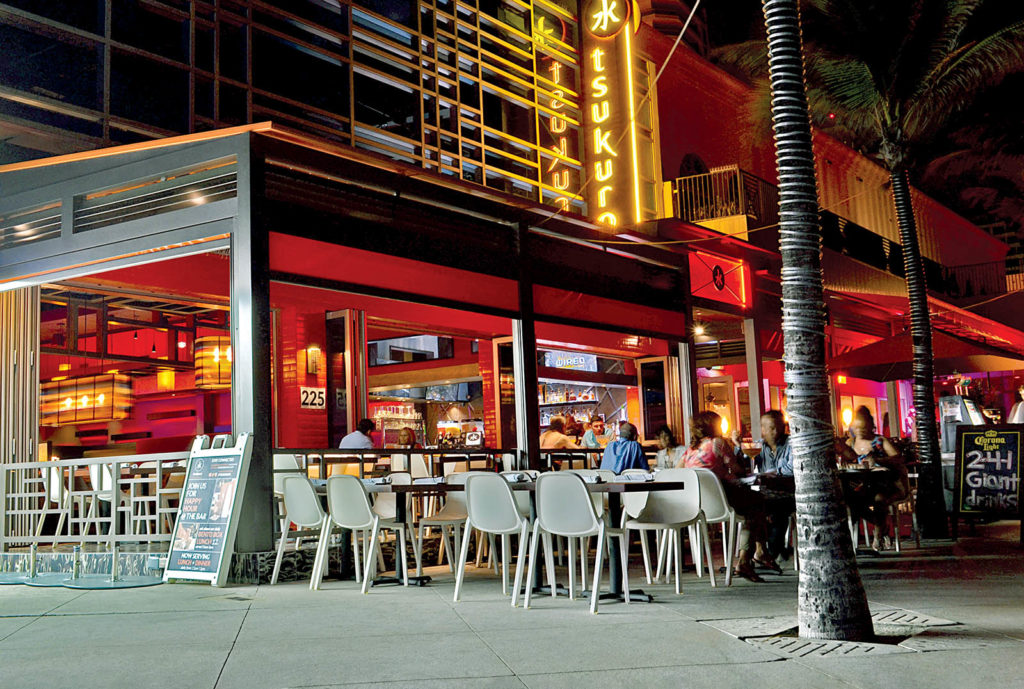
The COVID-19 pandemic has opened up tens of thousands of public gathering spaces by forcing proprietors to move their services outdoors and onto sidewalks and street fronts. While it is unclear how long these outdoor public sheltered spaces will remain in place, reports across the U.S. indicate that people (and businesses that have expanded outside) are expressing a desire to keep the invigorating spaces for well past the end of the pandemic, whenever that may be.
“COVID-19 brought about temporal designs of other kinds. Starting in spring 2020, cities from New York to Bethesda to Berkeley repurposed city streets for outdoor dining, allocated by hours of the day,” says Sara Hendren, professor at Olin College of Engineering, in The New York Times. Hendren included retail shops—from grocery stores to booksellers—in the observation. The swivel from indoors to outdoors has been felt intensely by awning/canopy and fabric structure fabricators across the land since the middle of last year, with no signs of letting up.
Some fabricators are expressing mixed feelings: Euphoria for the return of demand, along with frustrations over supply chain issues and increases in material costs. “Fabrication numbers are up in certain departments, but some departments are nowhere near what they were pre-COVID,” says Tim Koehler, customer solutions with Lawrence Fabric & Metal Structures Inc., St. Louis, Mo. “This would include dramatically increased costs for steel, aluminum and wood, along with increased lead times from the various mills. The supply issues are the big challenge. What used to be about three to four weeks’ lead time on supply deliveries are now about three to four months. We’re countering this situation by having to stock more in-house.”
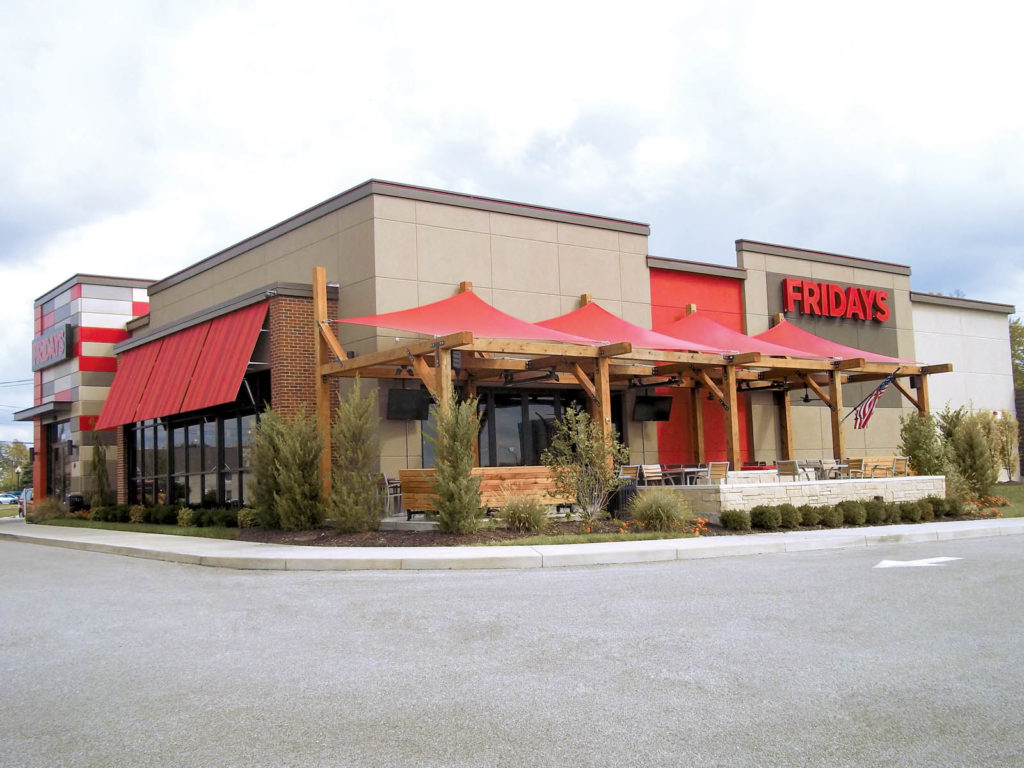
Demand continues
Many businesses have opted to commission a wide variety of standard shade and shelter formats, the most common being awnings and temporary shade structures. The time constraints and limited budgets many enterprises have to work with preclude any unusual shapes, colors or structural systems, leading them to opt for off-the-shelf units or standard spec fabrications that are the bread and butter for most fabricators. Still other fabricators have found an uptick of interest in tensioned fabric shelters that are designed to attract attention.
“There is a constant and growing interest from architects and parking structure tenants and owners to add visual enhancement,” says Angela Juarez, sales representative with Eide Industries Inc., Cerritos, Calif. And, support for this trend has come from more than just the public and their favorite eateries, but also local jurisdictions.
Mark Welander, owner of Fabricon LLC, Missoula, Mont., who has commissions for restaurant shades and shelters across the upper Midwest, finds the same intensity. “Demand has increased substantially this year, especially for outside seating.”
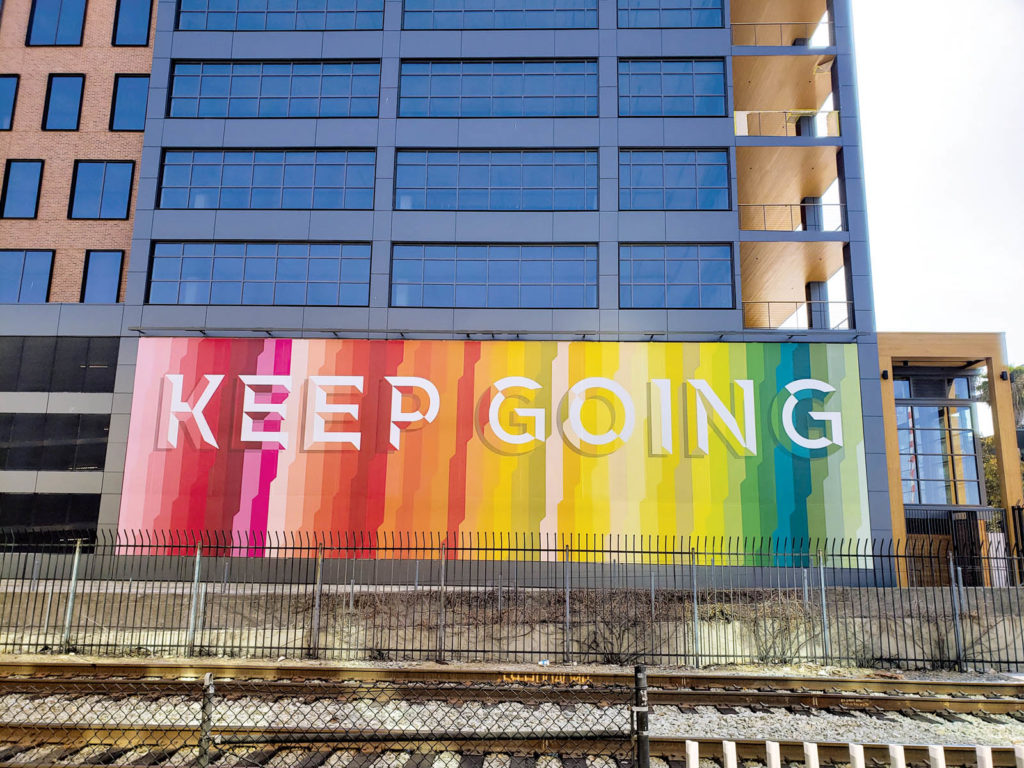
Funding for these outdoor shelters can come from many sources, both local and national, and almost certainly as a reaction to the pandemic’s impact on the economy. “We’re seeing a steady increase in requests for awnings and canopies for restaurants,” says Koehler. The CARES Act has provided funding for restaurants, and this has spurred the growth in part.
“This will continue, I think, as more chatter about government-backed programs launch, and this in turn can help us offer our clients a chance to increase their service areas and space with protection from the weather,” Koehler adds.
“We’re seeing more places where people are gathering outside for events needing to have shade and weather protection,” says Michele R. Taylor, business development manager and director of marketing, Birdair Inc., Amherst, N.Y., “all while giving the space a ‘wow’ factor, which we know tensile membrane structures can elegantly do with their unlimited design forms and flexible characteristics. Tensile structures are unconventional and being unique surely helps them stand out from the crowd.”
A signature design
With every project, the choices of materials are limited by budget, availability and the unique taste of the client, but successful fabricators have a good grip on what clients are asking for, how to keep budgets under control, and what helps push the project forward to completion based on good sales strategies. “Restaurant managers are aware of using any CARES Act dollars wisely,” says Koehler, “so we can make a convincing argument to clients for going with fabric versus metal canopies or awnings because of the significant savings fabric affords these projects.
“Another positive benefit with going with fabric is that it is appreciated by landlords or building owners when they have to replace empty storefront spaces with new tenants,” he adds. “It is so much easier to change out an old canopy (with the previous tenant’s logo and graphics) with fabric than if the canopies and awnings were metal. It just doesn’t make sense to use metal in these instances, so this scenario is part of our marketing message.”
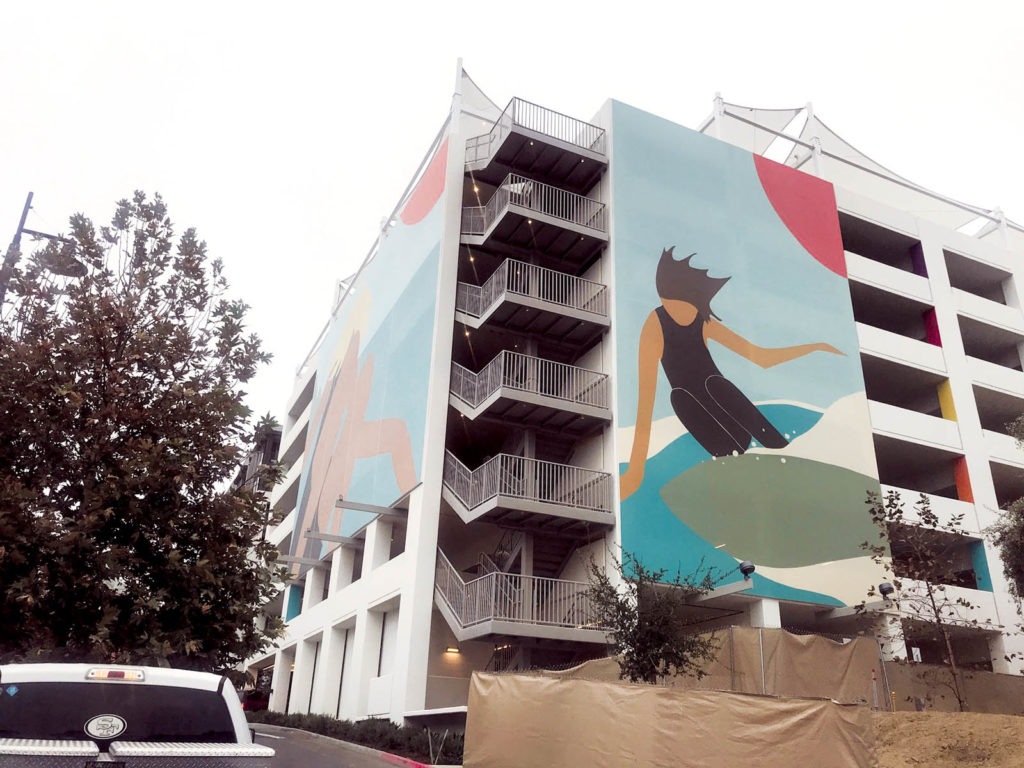
Birdair has found that dynamic, sculptural shade structures can make a good sale. “Fabric structures generate a signature design to the space and help provide a point of reference for people when meeting up somewhere,” says Taylor. “Tensile structures absolutely soften up the street experience with the natural daylighting underneath for people to enjoy and, equally, at night they can be lit up with multicolored LEDs that create an ambient exterior glow. It delivers that feeling of excitement that clients and architects are going for with their projects.”
Eide has found that fabric provides benefits beyond metal or other materials that include economic applications to existing structures without requiring major building modifications.
“For new structures, the facade attachment requirements can be built during construction,” says Juarez. “Fabric facades offer easy economic design changes to facade shape, color pattern, artwork and building coverage. Adding and/or enlarging the facade surface can easily be accomplished without any significant repair or resurfacing of the building. Facades can also be used to present varying themed areas.”
Fabric selection
Many fabricators have found that with high demand, tight turnaround times and supply chain challenges, the most expedient course to take has often meant using shop standard fabrics and assemblies.
For Lawrence Fabric & Metal Structures, Koehler says the types of fabric that are being spec’d for projects are still the typical PVC and acrylics that are usually in stock. “Nothing out of the ordinary, certainly not any custom colors that would require a rush on the mill and affect the limited budgets clients are under,” he says. “This choice of fabrics is also affected by the local code and permitting officials who are concerned about pushing projects through to completion on a timely manner.”
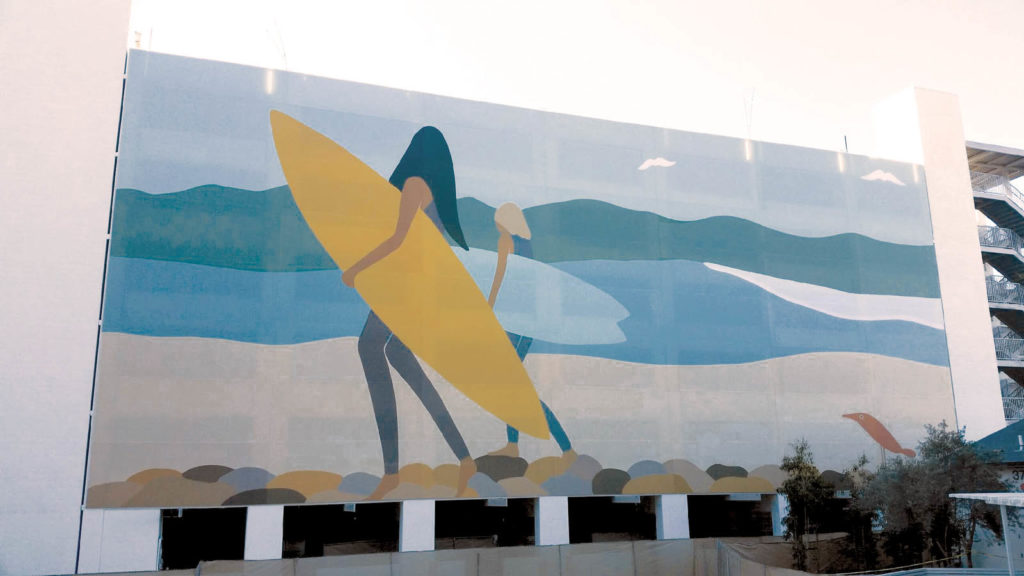
Taylor at Birdair says fabric selection is typically based on what aesthetics and performance requirements the client or architect are looking for. “The main fabrics we work with are PTFE, ETFE film and PVC. ETFE film provides a transparency look to the structure but not as much solar reflectance like translucent PTFE or PVC membrane. We know PTFE and ETFE are the most durable in terms of longevity and, of course, clients want to get the most life span out of a structure as possible. In terms of PTFE fabric, it’s a very low maintenance membrane due to the Teflon® coating that is easy to clean.”
According to Juarez at Eide, sometimes the sale point comes down to the durability of a fabric and a client’s willingness to pay. “Parking structures have certain ventilation requirements; therefore, the porosity of the fabric should be considered in the fabric selection,” When it comes to facades, many have artistic designs applied to the fabric using a rolled or printing ink process, so fabric selection should include verification of ink/fabric compatibility. “Most fabrics we’ve used with graphics have been Serge Ferrari FT 381, Soltis 86 and Soltis 92.”
Market outlook
While it can be risky to make predictions for the future, if trends continue as they currently are, there is every chance that significantly more work will come for fabric shade and shelter projects.
“I would say we could see more of the sidewalk occupation of serving spaces,” says Koehler, “because as more and more city storefronts get reoccupied, the need for service will only increase. So I expect that these restaurants and businesses will want to hold onto their sidewalk sheltered spaces to continue business growth.”
If local businesses have any say about this—based on customer feedback—it is very likely that local jurisdictions will find ways to adapt permitting to keep public streetscapes as visually invigorated as these examples have shown.
Bruce N. Wright, FAIA, is an architect and consultant to architects. He is a senior instructor at Dunwoody College of Technology and a frequent contributor to IFAI publications.
SIDEBAR: Capping a cafe
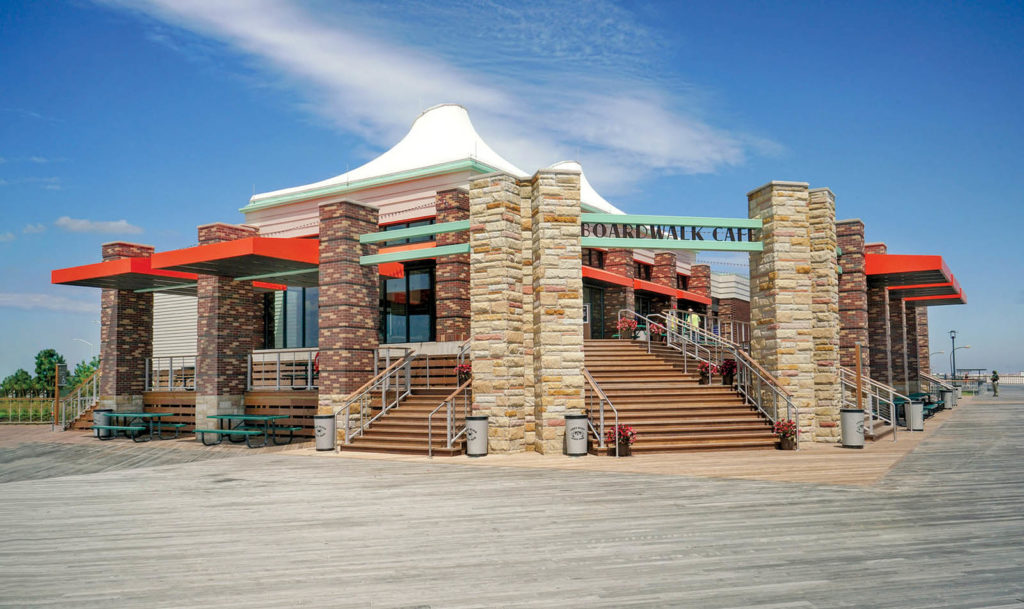
A recent restoration of the original Jones Beach Boardwalk Cafe, located at the Central Mall of Jones Beach State Park in Wantagh, N.Y., features twin tensile roof cones of white PTFE membrane insulated with Tensotherm™, designed and installed by Birdair Inc. The new public facility evokes the original 1930s building in a palette of stone and brick and houses concessions, game areas, a kitchen, restrooms, storage areas and vendor offices.
Project architects Beyer Blinder Belle Architects (BBB) collaborated with Arup, Scalamandre Construction and The LiRo Group on the $20 million project. According to a BBB press release, the series of stone masonry piers honors the footprint of the original building. The central design challenge was the Federal Emergency Management Agency’s requirement that the building be elevated 20 feet above the water and out of the coastal flood plain. A progression of cascading outdoor dining terraces and landscaped berms serve to camouflage the many piles needed to support the building.
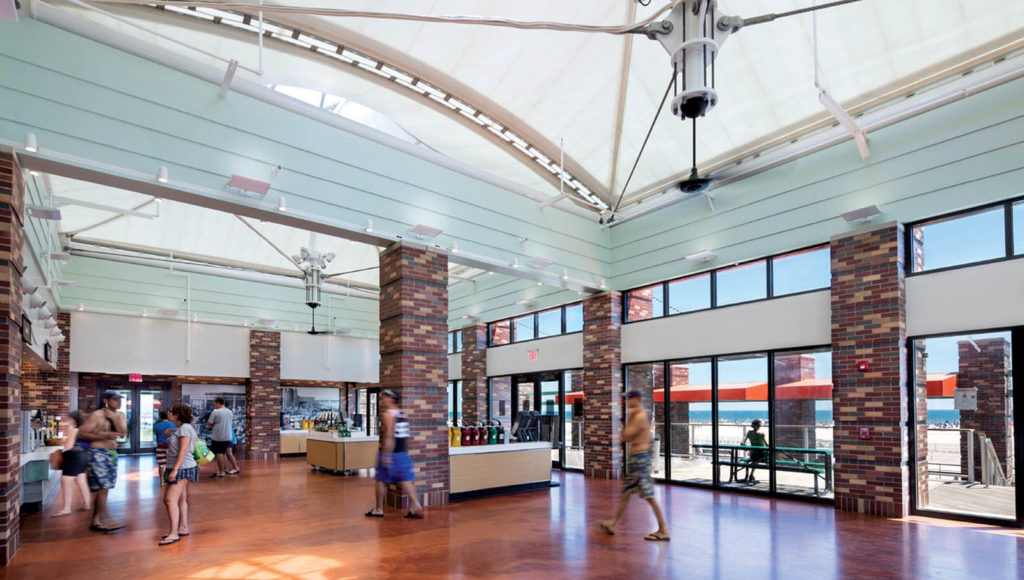
The double conical peaks are meant to evoke waves and sails and are supported by flying masts and taut cables that carry the loads to the edges, allowing a column-free space inside. “The project also includes four interconnected PTFE tensile canopies over a splash pad for children and adults to enjoy during hot weather,” says Michele Taylor, business development manager and director of marketing for Birdair. All sides of the central space are open toward the beach and water, brightly lit without the use of artificial lighting by the translucent fabric roofs.
SIDEBAR: Oceanside dining
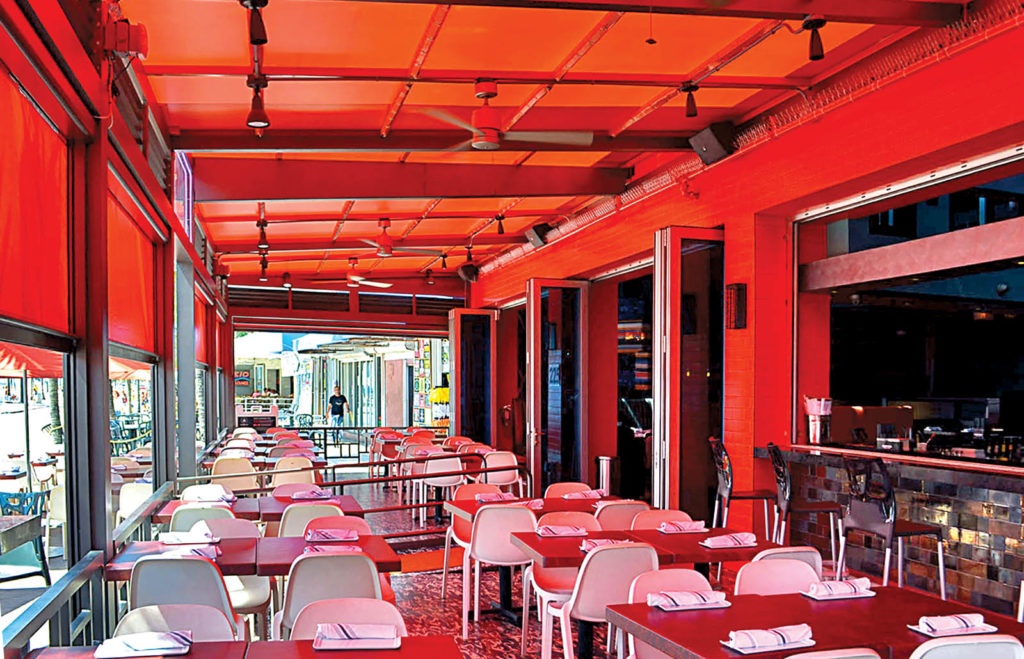
Tsukuro is a successful restaurant on Fort Lauderdale Beach’s mile-long strip facing the south Florida coast. Like most of the country responding to COVID-19 restrictions, it had to find a way to move service outside its two-story restaurant.
Hollywood, Fla.-based Awnings of Hollywood inserted a two-part seating arrangement between Tsukuro’s building and the street to create an inviting patio atmosphere. The front section utilizes square umbrellas that can be removed and stored if needed, and a more weather-protected section includes a fixed fabric canopy to filter sunlight and retractable solar shade curtains. The umbrellas and the canopy and side curtains feature a bold, warm red color that reflects the restaurant’s identity and history. Framing for the canopy was designed to match the geometric facade of Tsukuro’s original fascia patterns.
 TEXTILES.ORG
TEXTILES.ORG


